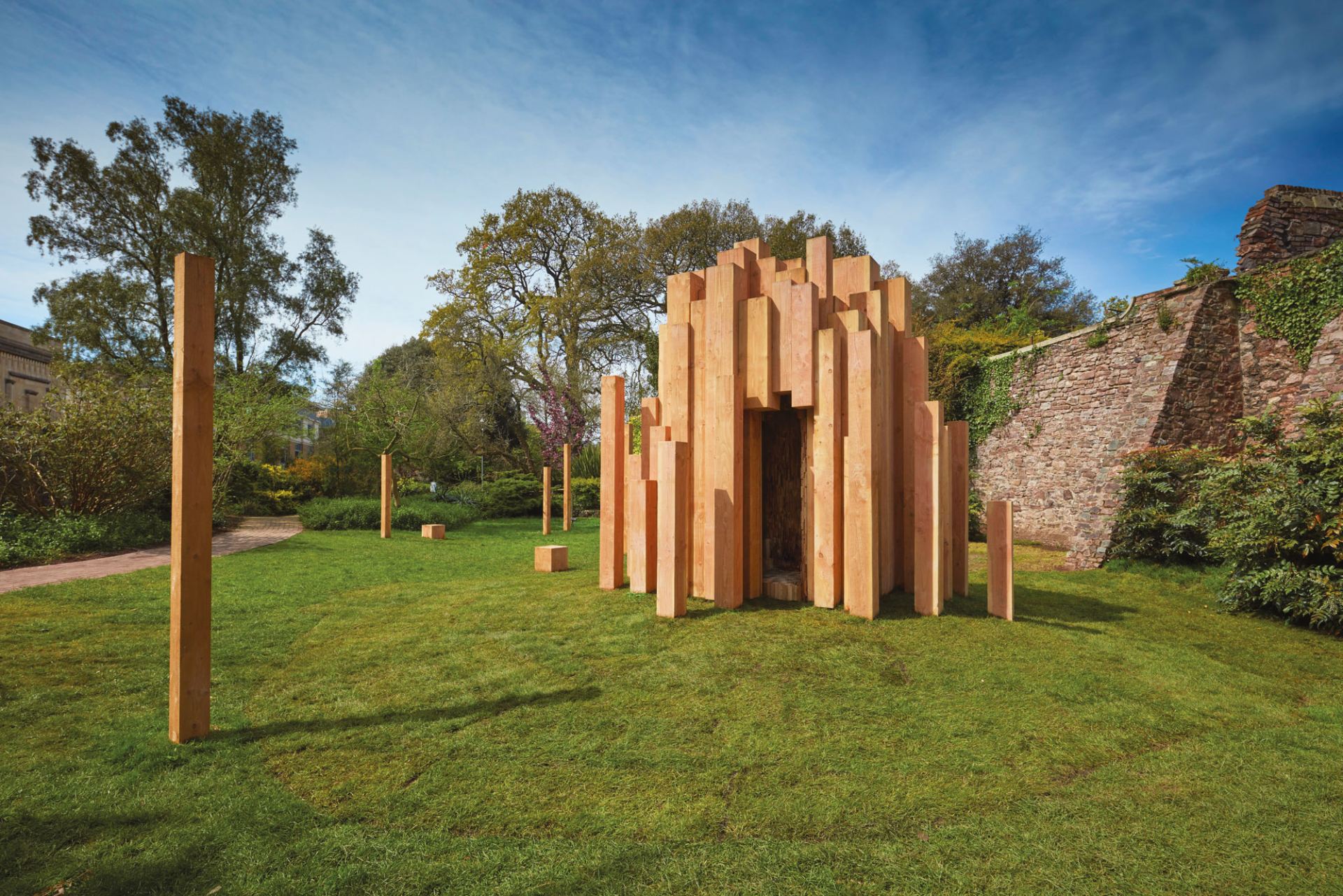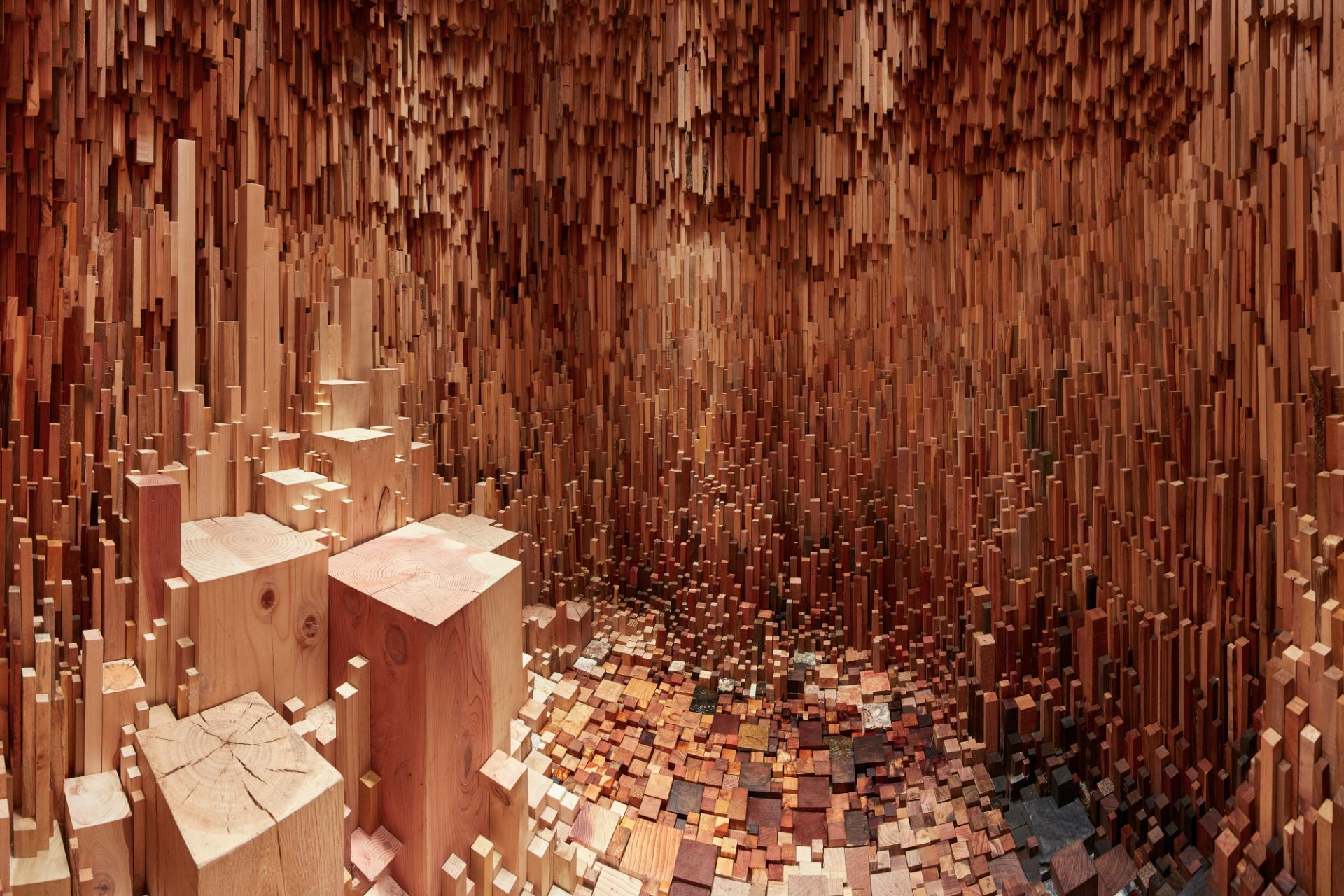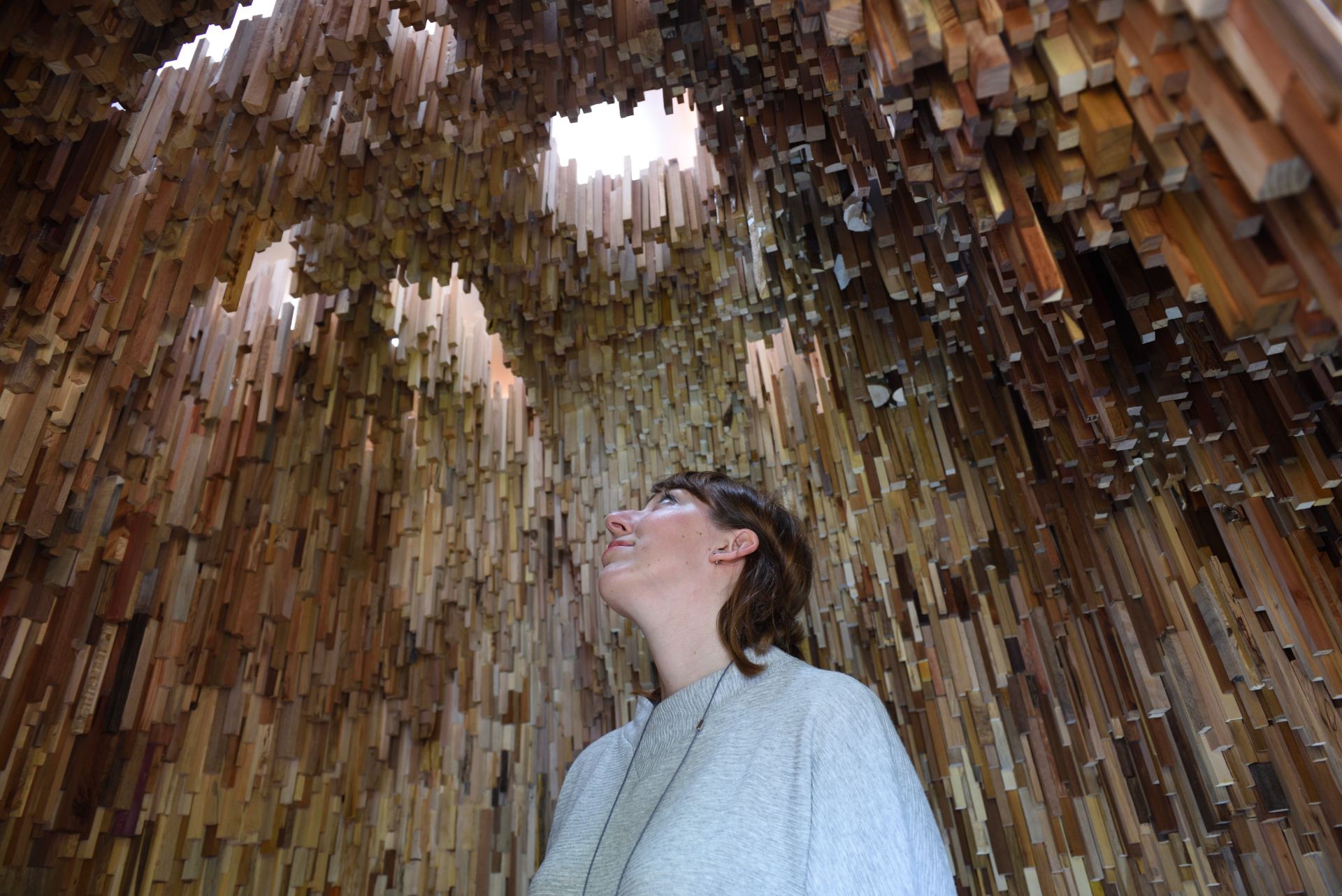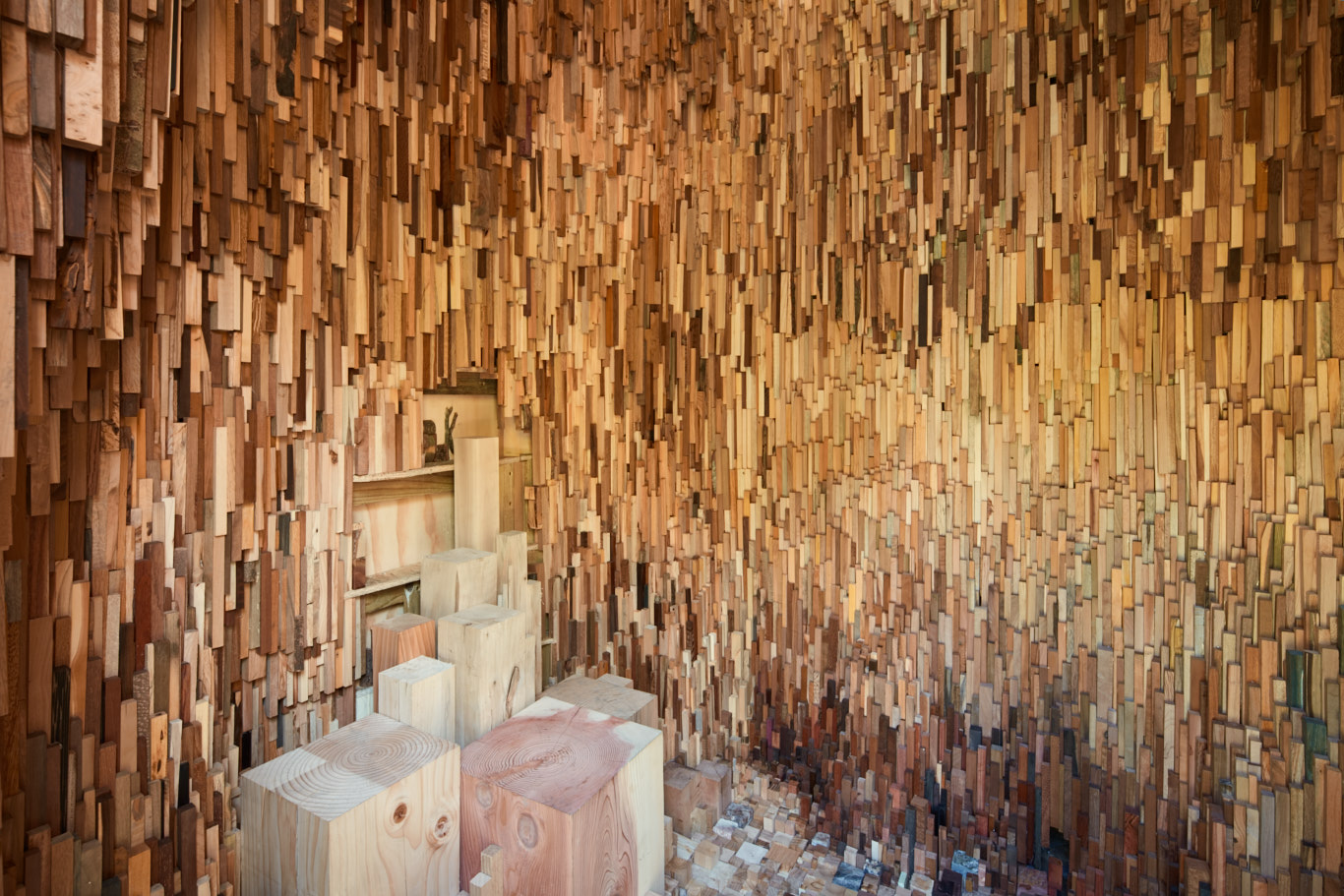Hollow (2016) is a an immersive artwork by Katie Paterson and architects Zeller & Moye, in association with the Faculty of Life Sciences at the University of Bristol. Commissioned to mark the opening of the £56.5million Life Sciences building, it was produced by Bristol-based public art producers, Situations.
Made up of 10,000 individual tree samples from across the globe, Hollow is a compendium of the world’s forests – designed to inspire wonder at the evolution of trees through time and the fragility of life on our planet.
The exterior structure of Hollow is made up of Douglas Fir and is inspired by a forest canopy, with the arrangements of posts representing the varying heights of trees.
Visitors are invited to step inside the sculpture via a small opening. Inside, we stand in a meditative space, surrounded by thousands of untreated wooden pieces, conjoined to form an immense cosmos of wooden stalactites. Natural light falls through apertures in the ceiling, mimicking the way dappled sunlight passes through trees in a forest.
The collection of wood samples, amassed by Katie Paterson over a three-year period, spans millions of years. From the oldest tree in the world to some of the youngest and near-extinct species, the tree samples contain within them stories of the planet’s history and evolution through time.
Most impressive is the fact that Paterson’s works, though highly conceptual, maintain a close connection between their means and ends. Paterson manages to convey the essence of a concept’s complexity without pushing you away. This is practice-based research par excellence, where the process of abstracting complex ideas and transforming them into simple experiences both forms and informs the work.
Lizzie Lloyd, Art Monthly 2016
Some samples are incredibly rare – fossils of unfathomable age, and fantastical trees such as Cedar of Lebanon, the Phoenix Palm, and the Methuselah tree thought to be one of the oldest trees in the World at 4847 years of age, as well as a railroad tie taken from the Panama Canal Railway, which claimed the lives of between 5,000 to 10,000 workers over its 50 year construction and wood is salvaged from the remnants of the iconic Atlantic city boardwalk devastated by hurricane Sandy in 2012.
The relationship between Hollow and the Life Sciences building is important; they both explore different but complementary ways to engage with and examine nature.
The Life Sciences building, which was opened by Sir David Attenborough in 2014, is the University’s biggest capital project to date and serves as a multi-disciplinary interactive hub for biologists, biochemists, computer scientists, engineers, mathematicians and Earth scientists.
Dr. Jon Bridle is an evolutionary biologist who worked on the project. His research focuses on how quickly populations can evolve to cope with changes in their environment, and so potentially avoid extinction.
The study of life is crucial to addressing many of the acute challenges that face humanity this century, such as food security, biodiversity loss, and climate change. Commissioning a public artwork to explore some of these themes is an exciting way to celebrate this, and to allow us to connect in new and previously unimagined ways with some of the beauty, complexity and depth of the natural world. It’s also absolutely fantastic for us as scientists, and for the wider community, to be able to engage with the work of an artist like Katie Paterson.
The life scientists played a big part. One thing I struggled with was how to systematise the trees in the structure. What we came up with was not imposing another human narrative on it.The one thing it does run with is time, from the new to the extinct species. Jon Bridle was really involved. He gave a lot of insight into the way human beings relate to trees, going back through time and culture.
Katie Paterson
Katie Paterson (b. 1981, Scotland) is widely regarded as one of the leading artists of her generation. Collaborating with scientists and researchers across the world, Paterson’s projects consider our place on Earth in the context of geological time and change.
Katie’s artworks make use of sophisticated technologies and specialist expertise to stage intimate, poetic and philosophical engagements between people and their natural environment. In the past, she has broadcast the sounds of a melting glacier live to a visitor on a mobile phone in an art gallery, mapped all the dead stars by compiling a slide archive of the history of darkness across the ages, custom-made a light bulb to simulate the experience of moonlight, and buried a nano-sized grain of sand deep within the Sahara desert.
Katie Paterson was winner of the Independent’s Creative 30 award ‘for Britain’s most creative young person’ and has won 2014 South Bank Sky Arts Award. In 2013, she was awarded an Honorary Fellowship at Edinburgh University in recognition of her ‘major contribution in fostering collaboration between the arts and sciences’.
Zeller and Moye
Christoph Zeller and Ingrid Moye founded Zeller & Moye as an architectural studio that operates with an interdisciplinary and global approach, with bases in Mexico City and Berlin. The studio established a unique working method of extensive experimentation for the development of a project in order to articulate meaningful proposals for the contemporary world. Zeller & Moye has designed a wide range of projects at all scales from furniture design to large cultural buildings in different parts of the world.
Location and access
Royal Fort Gardens, Tyndall Avenue, BS8 1TH UK
- Google Maps location: Royal Fort Gardens, Bristol, BS8 1UH
- What3Words location: smug.poker.wire
Hollow is permanently located in the south-eastern corner of Royal Fort Gardens, to the right of the Tankard’s Close entrance to the gardens. The gardens can also be accessed via the entrance on Tyndall Avenue, just follow the path to the other side of the gardens.
Royal Fort Gardens are open every day of the year and the interior of Hollow is open during daylight hours. Opening times may vary during the summer months and holidays are at the discretion of the University.
There is level access into Royal Fort Gardens and the area around the sculpture. The entrance is narrow with a low step inside. The floor, which comprises fossil fragments, is uneven. The interior is naturally lit and therefore may be dim on cloudy days or at dusk. We would advise only one or two people at a time enter Hollow to fully experience the work.
Further resources
- Hollow: a specially commissioned companion website to explore the stories and responses to the artwork, to find out more about the artist architects and partners involved. Digitally explore every tree sample contained within the artwork and scroll around a multi-dimensional view of the interior.
- Hollow In Conversation (9 May 2016, Soundcloud). In this conversation chaired by Dr Edson Burton, Katie Paterson and architects Zeller & Moye describe how Hollow was created. The artists are joined by Dr Jon Bridle, from the School of Biological Sciences.
- Katie Paterson artist talk at Arnolfini, featuring John Bridle, School of Biological Sciences.
Situations: Katie Paterson
Katie Paterson steps inside her public artwork, Hollow. A sculpture celebrating the life of the planet by creating a miniature forest of all the world’s trees.
What Do Artists Do All Day?
The creation of Katie Paterson’s Hollow was filmed for BBC Four’s ‘What Do Artists Do All Day?’ series which was broadcast in 2016.
Situations: Zeller and Moye
Interview with architects Zeller and Moye about the experience of designing Hollow and working on the project.




